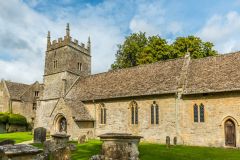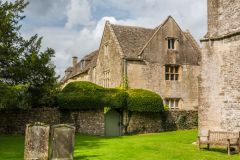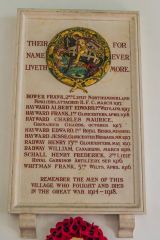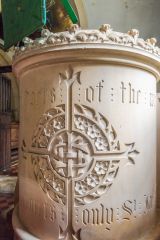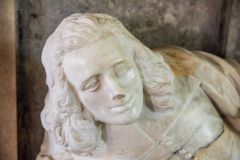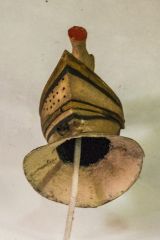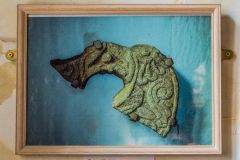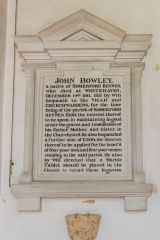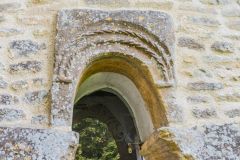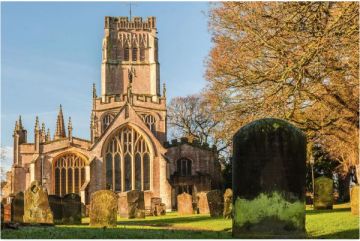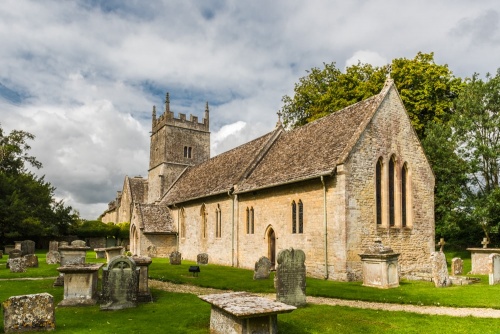
There has been a church in the Gloucestershire village of Somerford Keynes since the 7th century, when the monks of Malmesbury Abbey owned land here. In AD 685 Berhtwald, a relative of King Ethelred and later the 9th Archbishop of Canterbury, granted the abbey land in Somerford Keynes. The monks established a preaching centre, with a rough timber church, and baptised Christian converts in the nearby River Thames.
History
By AD 695 the monks had replaced that timber church with a stone building, making it among the oldest stone churches in the county. The north doorway from that early Saxon building still survives. Around AD 750 the monks erected a timber bell turret. This was torn down in 1708 and the present stone tower built in 1715.
The village takes the 'Keynes' part of its name from the Keynes family, who were lords of the manor from roughly 1100 to 1300. The Keynes family rebuilt the Saxon church around 1215 and the present nave, chancel and north chapel survive from this period. The porch was added later in the 13th century.
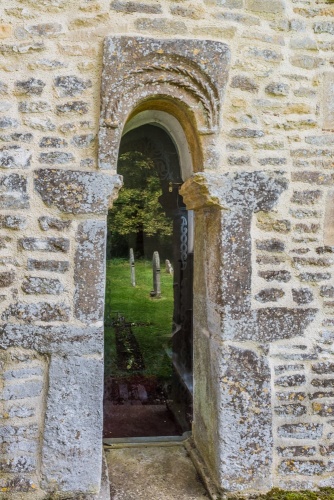
The church was comprehensively rebuilt in 1875 by the architect Frederick Waller. Like many Victorian 'restorations' much of the medieval structure was swept away. Most of the medieval and later gravestones were lost, except for a single grave slab to the Foyle family in the tower arch and two smaller stones set into the tower floor.
The porch retains its 13th-century stone benches and its original medieval oak door.
At some point in the 13th century a pair of arches were cut into the north wall of the church and the north chapel inserted. This was extended to create a vestry in the Victorian restoration.
In the chapel is a memorial to Robert Strange (d 1654) the last of the Strange family to be lords of the manor. Also in the chapel is a large wooden parish chest.
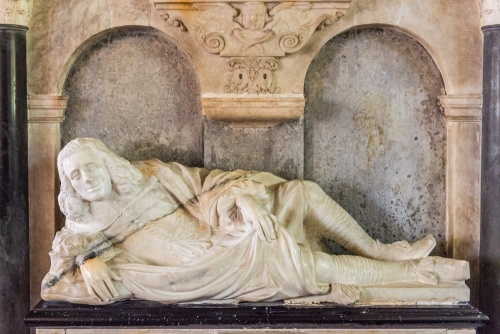
The chancel dates to around 1220 and boasts an elaborately carved piscina, an unusual feature for a small country church.
One of the church highlights is a nicely carved chancel screen built around 1483 and still boasting its original 15th-century lock.
The pulpit was installed in 1876 and is made with Coade stone (also known as Lithodipyra), which is an artificial stone based on a mix of clay, quartz, and flint that could be easily moulded into complex shapes. Behind the pulpit is a squint, built to allow worshippers to view a now-vanished nave altar.
The font is a relic of the Norman church and was carved around 1100. It stands on a 14th-century stem.
Set into the floor near the font are 13th-century coffin lids discovered during the 1875 restoration. The small slab probably marked the burial place of a child.
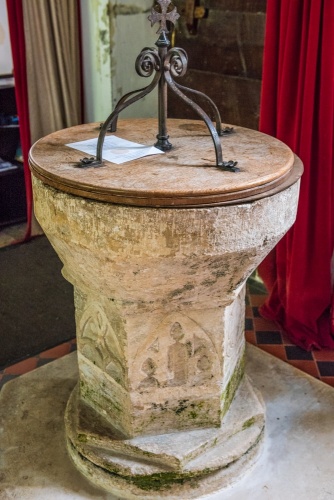
The Saxon Doorway
Set into the north wall of the nave opposite the south entrance is the 7th-century doorway. Like most Saxon doorways this one is tall and narrow, with a rounded arch. The doorway was blocked and hidden by plaster around 1500 and was only reopened in 1968, almost 1300 years after it was built.
The doorway has been glazed so that visitors can fully appreciate it from both sides. We highly recommend walking around the outside of the church to view the Saxon doorway from the outside.
Saxon Sculpture
One of the treasures of Somerford Keynes church is a fragment of late Saxon sculpture dating to the reign of King Cnut (1016-1035). The sculpture is Scandinavian in style and probably formed part of a gravestone. It depicts two beasts facing each other, with a round ball between them. The carving was stolen from the church in 2012. It was recovered and is now on display at the Corinium Museum in Cirencester for safekeeping.
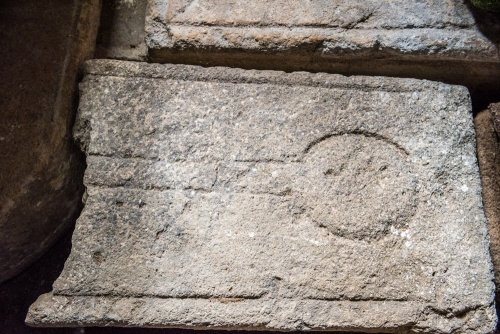
Other historical highlights inside the church include a worn carved head, discovered in the porch and moved within the church to protect it. The carved head is immediately below a marble memorial to John Bowley, a native of Somerford Keynes who left £200 to provide for four poor men and four poor women of the parish. He left a further £100 to maintain the graves and headstones of his mother, father and sister in the graveyard.
Also on the wall is a memorial to the ten men of Somerford Keynes who died in the First World War. Five of the ten men came from the Hayward family and all fought with different regiments.
All Saints Church is a delight, a beautiful country church full of historical interest. The Saxon doorway is a remarkable 7th-century survivor, and the church's location beside the 15th-century manor house is idyllic.
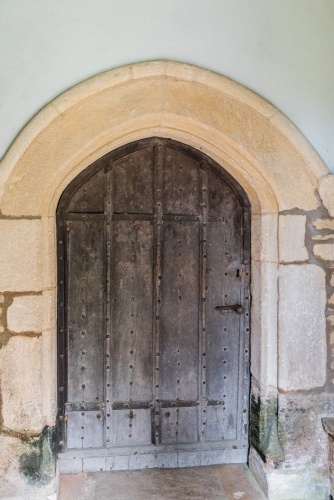
Getting There
All Saints Church is immediately beside the Manor House in the northern part of Somerford Keynes village, off Main Street. The village is easily reached off the Spine Road (West) in the Cotswold Water Park.
Our family has visited the church twice, and both times we've elected to park in the neighbouring village of Ashton Keynes and take the Thames Path long-distance footpath, which leads through the Water Park to Somerford Keynes. It is a lovely walk beside the peaceful Thames.
About Somerford Keynes, All Saints Church
Address: Somerford Keynes,
Wiltshire,
England, GL7 6DL
Attraction Type: Historic Church
Location: Off Arlington Drive in Somerford Keynes, accessed via the Spine Road (West) in the Cotswold Water Park.
Website: Somerford Keynes, All Saints Church
Location
map
OS: SU016955
Photo Credit: David Ross and Britain Express
HERITAGE
 We've 'tagged' this attraction information to help you find related historic attractions and learn more about major time periods mentioned.
We've 'tagged' this attraction information to help you find related historic attractions and learn more about major time periods mentioned.
Find other attractions tagged with:
NEARBY HISTORIC ATTRACTIONS
Heritage Rated from 1- 5 (low to exceptional) on historic interest
Shorncote, All Saints Church - 1 miles (Historic Church) ![]()
Ashton Keynes, Holy Cross Church - 1.7 miles (Historic Church) ![]()
South Cerney, All Hallows Church - 2.4 miles (Historic Church) ![]()
Thames Head - 3.2 miles (Countryside) ![]()
Leigh, All Saints Church - 3.6 miles (Historic Church) ![]()
Cirencester Roman Amphitheatre - 3.6 miles (Roman Site) ![]()
Cirencester, St John the Baptist - 4 miles (Historic Church) ![]()
Corinium Museum - 4.1 miles (Museum) ![]()
Nearest Holiday Cottages to Somerford Keynes, All Saints Church:
Cotswold Water Park, Gloucestershire
Sleeps: 8
Stay from: £956 - 4502
Somerford Keynes, Gloucestershire
Sleeps: 6
Stay from: £638 - 2549
Cirencester, Gloucestershire
Sleeps: 4
Stay from: £459 - 1813
More self catering near Somerford Keynes, All Saints Church
